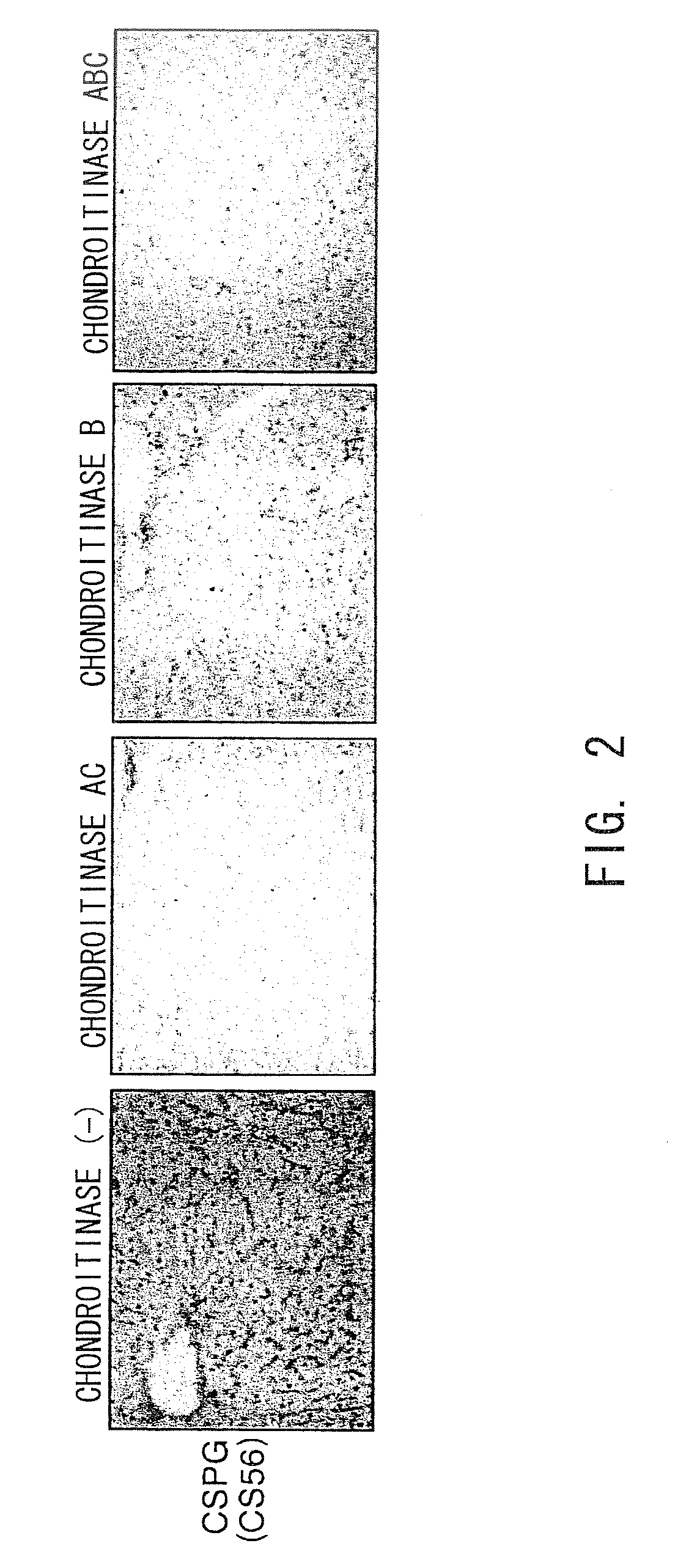Agents for suppressing hepatic fibrosis
a technology for hepatic fibrosis and agents, applied in the field of agents for suppressing hepatic fibrosis, can solve the problems of significant impairment of patient's quality of life, no radical treatment method for the disease, recurrence of fibrosis, etc., and achieve the effect of suppressing fibrosis of liver tissues, enhancing liver tissue fibrosis, and reducing recurren
- Summary
- Abstract
- Description
- Claims
- Application Information
AI Technical Summary
Benefits of technology
Problems solved by technology
Method used
Image
Examples
example 1
Increase in the Expression Level of Chondroitin Sulfate Proteoglycans (CSPGs) in Cirrhosis Mouse Models
[0196]In this Example, a cirrhosis mouse model was prepared using a mouse liver fibrosis model induced by carbon tetrachloride (CCl4), which is a typical example of mouse model for chronic fibrotic liver diseases, and is examined for the accumulation of proteoglycans using immunohistochemical staining. This liver fibrosis mouse model has superior reproducibility and is widely used as an experimental cirrhosis model (Sakaida I, et al., Hepatology 2004, 40, 1304-1311).
[0197]First, carbon tetrachloride (25 μl / 100 g body weight, Sigma-Aldrich) was injected into the peritoneal cavities of C57BL / 6JcL mice (female, five to six weeks old, CLEA Japan Inc.) twice a week for four weeks (eight times) to induce liver fibrosis. Then, carbon tetrachloride was additionally administered twice a week for two weeks (12 times in total) to induce cirrhosis. Mice with induced cirrhosis were sacrificed, ...
example 2
Ability of Various Chondroitinases to Cleave Chondroitin Sulfate Accumulated in Mouse Cirrhotic Livers
[0201]In this Example, each type of chondroitinase was evaluated for its ability to cleave chondroitin sulfate (CSPG) in tissue sections from cirrhotic livers. Using the procedure described below, tissue sections of the cirrhotic livers were treated with chondroitinase, and after the enzyme reaction, residual CSPG in the tissue sections, specifically CSPG that was not cleaved in the chondroitinase treatment, was detected by the immunostaining method.
[0202]First, carbon tetrachloride (25 μl / 100 g body weight, Sigma-Aldrich) was injected into the peritoneal cavities of C57BL / 6JcL mice (female, five to six weeks old, CLEA Japan Inc.) twice a week for four weeks (eight times) to induce liver fibrosis. Then, carbon tetrachloride was additionally administered twice a week for two weeks (12 times in total) to induce cirrhosis. Mice with induced cirrhosis were sacrificed, and their livers w...
example 3
The Hepatic Fibrosis-Suppressing Effect of Chondroitinase ABC (Chase ABC) in Cirrhosis Mouse Models
[0208]Carbon tetrachloride (25 μl / 100 g body weight, Sigma-Aldrich) was injected into the peritoneal cavities of C57BL / 6JcL mice (female, five to six weeks old, CLEA Japan Inc.) twice a week for four weeks (eight times) to induce liver fibrosis. Then, carbon tetrachloride was additionally administered twice a week for two weeks (12 times in total).
[0209]Prior to further administration, an Alzet Osmotic Pump (Muromachi Kikai Co. Ltd.) pre-infused with 150 μl of chondroitinase ABC (Chase ABC) (20 U / ml, Sigma-Aldrich), chondroitinase AC (Chase AC) (20 U / ml, Sigma-Aldrich), chondroitinase B (Chase B) (20 U / ml, Sigma-Aldrich), or PBS alone was surgically implanted within the peritoneal cavity of each mouse. The respective groups of mice treated as described above were named Chase ABC enzyme group, Chase AC enzyme group, Chase B enzyme group, and control group. During two weeks of further ad...
PUM
| Property | Measurement | Unit |
|---|---|---|
| weight | aaaaa | aaaaa |
| concentration | aaaaa | aaaaa |
| temperature | aaaaa | aaaaa |
Abstract
Description
Claims
Application Information
 Login to View More
Login to View More - R&D
- Intellectual Property
- Life Sciences
- Materials
- Tech Scout
- Unparalleled Data Quality
- Higher Quality Content
- 60% Fewer Hallucinations
Browse by: Latest US Patents, China's latest patents, Technical Efficacy Thesaurus, Application Domain, Technology Topic, Popular Technical Reports.
© 2025 PatSnap. All rights reserved.Legal|Privacy policy|Modern Slavery Act Transparency Statement|Sitemap|About US| Contact US: help@patsnap.com



